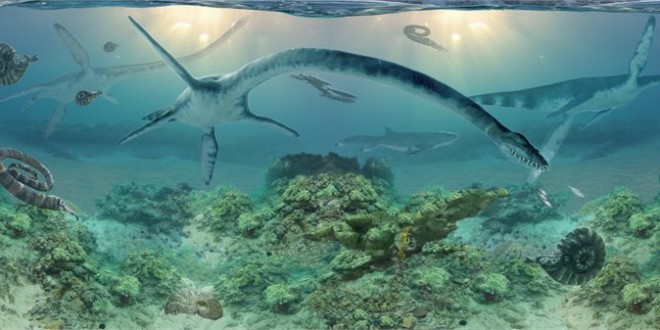Elasmosaur – Ancient Reptile with ‘Ridiculously Long Neck’ Unearthed in Alaska.
Earth sciences curator Patrick Druckenmiller said elasmosaurs are a type of plesiosaur with extremely long necks and two pairs of paddle-like limbs used to swim under water. They lived during the Late Cretaceous period about 70 million years ago. “Picture the mythical Loch Ness monster and you have a pretty good idea what it looked like. This is an exciting find because it is the first time an elasmosaur has ever been discovered in Alaska.”
Over the past few years, Curvin Metzler, an Anchorage-based fossil collector, found several vertebrae from the skeleton eroding out of a bluff. He’d been hiking in the area for 25 years and this was the first vertebrate fossil he found there. When Metzler, Druckenmiller and two others visited the site in June, they were able to identify the source of the bones in the hillside and collect a good portion of the skeleton.
“I’m mostly interested in finding invertebrates, so when I saw the first vertebra I knew it was a bone from something,” Metzler said. “I didn’t want to disturb anything in the cliff so it was exciting to talk to Pat. We are lucky to have someone in the state who works with fossils.”
Even though the new elasmosaur is a first for the state, Druckenmiller has collected plesiosaurs from all over western North American and is one of the world’s marine reptile fossil experts. In 2010, he led a team that collected a nearly complete elasmosaur skeleton from Montana, which is currently on display as part of the museum’s “Expedition Alaska: Dinosaurs” exhibit in Fairbanks.
“I was really excited the first time Curvin showed me one of its bones,” he said. “I recognized it as a vertebra from the base of the animal’s neck and wanted to visit the site to see if we could find more. Based on the size of the bones we excavated, the animal should be at least 25 feet long.”
The skeleton was located about halfway up a 60-foot vertical cliff. The fossil is eroding out of the hillside with about 30 feet of rock piled on top. “We got a good chunk of the animal but there is still more to excavate.” Druckenmiller hopes to recover the rest of the specimen next summer.
Metzler stressed the value of this fossil. “Something like this belongs in a museum where researchers can learn more about this group of animals.”
Plesiosaurs are one of three types of ancient marine reptiles discovered in Alaska. Specimens of ichthyosaurs and thalattosaurs have been previously collected by the museum’s earth sciences crew. Some of those are also on display as part of the museum’s special exhibit through summer 2016.
Agencies/Canadajournal
 Canada Journal – News of the World Articles and videos to bring you the biggest Canadian news stories from across the country every day
Canada Journal – News of the World Articles and videos to bring you the biggest Canadian news stories from across the country every day



